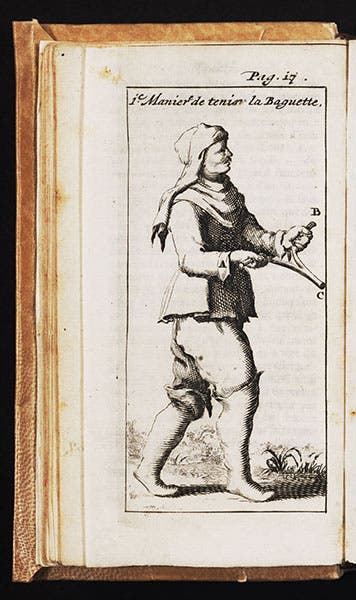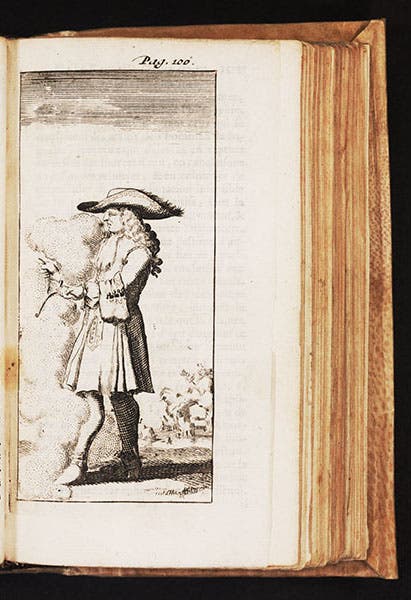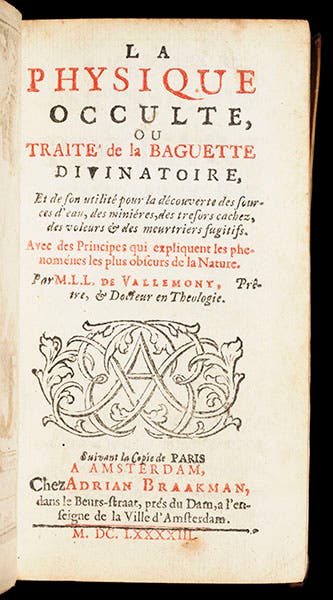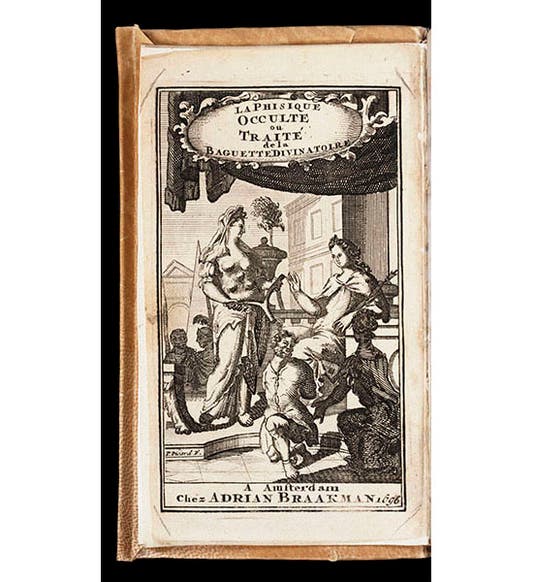Scientist of the Day - Abbe de Vallemont
Pierre Le Lorrain, the abbé de Vallemont, was born Sep. 10, 1649. In the summer of 1692, a wine merchant of Lyon and his wife were murdered, and when the authorities were stymied, it was suggested that they call in Jacques Aymar, a master of la baguette. A baguette was a divining rod, a forked stick made of hazel wood that had been used for centuries to locate underground water and veins of ore.

Vallemont, (Pierre Le Lorrain). La physique occulte; ou Traité de la baguette divinatoire, et son utilité pour la découverte des sources d’eau, des minières, des tresors cachez, des voleurs & des meurtriers fugitifs ... Par M. L. L. de Vallemont ... Augmenté en cette edition, d’un traité de la connoissance des causes magnetiques des cures sympathiques, des transplantations & comment agissent les philtres. Par un curieux de la nature. Suivant la copie de Paris. Chez Adrian Bkaakman, 1696. (Linda Hall Library)
Aymar wielded his baguette in a different fashion. He used his rod to reconstruct crime scenes (he was able to point to the exact spots where the two victims lay), and then he led police on an extensive trail to a nearby town where his baguette fingered a young hunchback, Joseph Arnoul. His two accomplices had fled to Italy, but Joseph was taken back to Lyon, where he confessed to the crime and was then executed.
Absolutely no one at the time disputed that Aymar was able to detect traces of blood with his divining rod and that he had led the police to one of the killers. But how did the baguette work? – that was a much more lively question. In the previous century, most agreed that the divining rod worked by some sort of natural magic, so that the hazel wood might have a sympathetic attraction to water, or to metal, and respond accordingly. But in the last half of the 17th century, occult forces such as sympathies were losing favor, and the mechanical philosophy was rapidly gaining ground. According to the principal author of the mechanical philosophy, René Descartes, the world is made of various kinds of inert matter, and all motions are the result of mechanical interactions of matter pushing on matter. Even magnetism could be explained as the global circulation of invisible particles.

Vallemont, (Pierre Le Lorrain). La physique occulte; ou Traité de la baguette divinatoire, et son utilité pour la découverte des sources d’eau, des minières, des tresors cachez, des voleurs & des meurtriers fugitifs ... Par M. L. L. de Vallemont ... Augmenté en cette edition, d’un traité de la connoissance des causes magnetiques des cures sympathiques, des transplantations & comment agissent les philtres. Par un curieux de la nature. Suivant la copie de Paris. Chez Adrian Bkaakman, 1696. (Linda Hall Library)
There were no sympathies or magical effects in the mechanical world of Descartes and his followers.
Valllemont was a Cartesian. He believed in Aymar's dowsing abilities – in fact, he interviewed Aymar extensively – and he had no doubt that Aymar had successfully tracked down a killer with his baguette. But there had to be a mechanical explanation. Vallemont proposed that humans leave behind corpuscles wherever they go, shedding them rather like skin cells, and wounded humans even more so. These blood particles are therefore detectible, and just as the eye is an organ for focusing and detecting light particles, a baguette focuses particles of blood, or water, or minerals, and a dowser is someone who is able to detect their presence. A divining rod is not an implement of magic; it is, in the right hands, just a particle detector, as the image below dramatically illustrates.

Vallemont, (Pierre Le Lorrain). La physique occulte; ou Traité de la baguette divinatoire, et son utilité pour la découverte des sources d’eau, des minières, des tresors cachez, des voleurs & des meurtriers fugitifs ... Par M. L. L. de Vallemont ... Augmenté en cette edition, d’un traité de la connoissance des causes magnetiques des cures sympathiques, des transplantations & comment agissent les philtres. Par un curieux de la nature. Suivant la copie de Paris. Chez Adrian Bkaakman, 1696. (Linda Hall Library)
In 1693, Vallemont published his Cartesian account of the divining rod: La physique occulte; ou Traité de la baguette divinatoire (Occult Physics, or Treatise on the divining rod).

Vallemont, (Pierre Le Lorrain). La physique occulte ; ou Traité de la baguette divinatoire, et de son utilité pour la découverte des sources d’eau, des miniéres, des tresors cachez, des voleurs & des meurtriers fugitifs. Avec des principes qui expliquent les phenoménes les plus obscurs de la nature / par M.L.L. de Vallemont. Chez Adrian Braakman, 1693. (Linda Hall Library)
We have this book in our History of Science Collection, and much of the foregoing is an attempt to explain why a science library has a book on divining rods in its collection. We also have the 1696 second edition of this book, and since it opens better than the first edition, all of the images here except the title page are from the second edition.
Dr. William B. Ashworth, Jr., Consultant for the History of Science, Linda Hall Library and Associate Professor, Department of History, University of Missouri-Kansas City. Comments or corrections are welcome; please direct to ashworthw@umkc.edu.





![Columbine, hand-colored woodcut, [Gart der Gesundheit], printed by Peter Schoeffer, Mainz, chap. 162, 1485 (Linda Hall Library)](https://assets-us-01.kc-usercontent.com:443/9dd25524-761a-000d-d79f-86a5086d4774/3829b99e-a030-4a36-8bdd-27295454c30c/gart1.jpg?w=210&h=210&auto=format&fit=crop)
